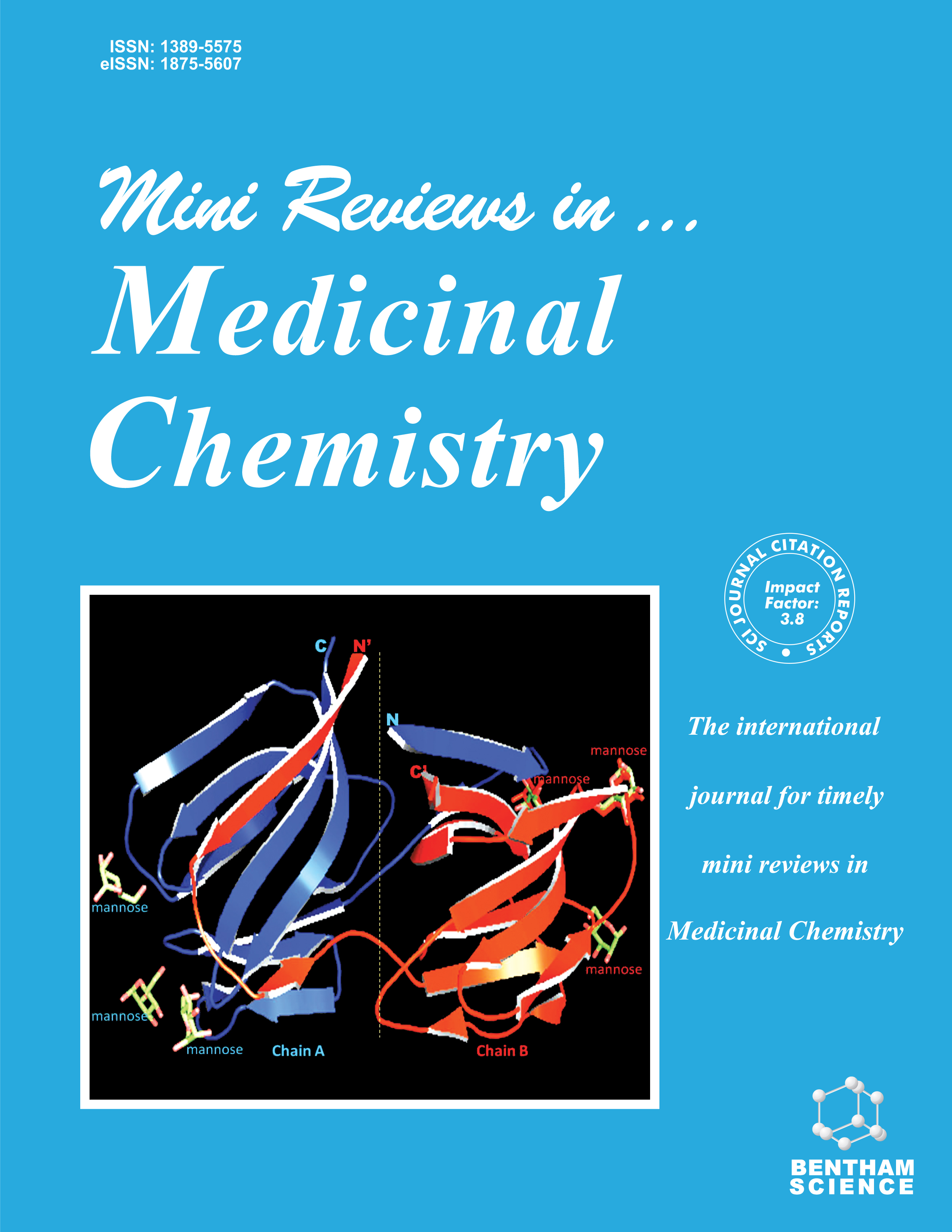- Home
- A-Z Publications
- Mini Reviews in Medicinal Chemistry
- Previous Issues
- Volume 6, Issue 9, 2006
Mini Reviews in Medicinal Chemistry - Volume 6, Issue 9, 2006
Volume 6, Issue 9, 2006
-
-
Hydrophilic Carotenoid Amphiphiles: Methods of Synthesis and Biological Applications
More LessAuthors: Bente Jeanette Foss, Geoff Nadolski and Samuel F. LockwoodCarotenoid bioactivity, namely the quenching of reactive oxygen species (ROS) and other excited-state oxidants, suggests significant clinical potential for these natural products. However, a thorough therapeutic evaluation of the carotenoids has been hampered by limited water-solubility and/or water-dispersibility (“hydrophilicity”) as well as poor bioavailability. Hydrophilic carotenoid derivatives have been designed and pr Read More
-
-
-
Modulation of Catalytic RNA Biological Activity by Small Molecule Effectors
More LessCatalytic RNAs, known as ribozymes, act as true enzymes and are implicated in important biological processes, such as protein synthesis, mRNA splicing, transcriptional regulation and retroviral replication. Ribozymes are capable of serving as a new molecular target for a variety of drugs and as a reliable screening system for their biological activity.
-
-
-
Utilizing Peptide Structures As Keys For Unlocking Challenging Targets
More LessAuthors: David Fry and Hongmao SunThree-dimensional structures of protein targets have proven to be extremely valuable for modern drug design and discovery. For cases where the structure of the protein is unattainable, such as G-protein coupled receptors (GPCRs), structural information on active ligands is still useful and helpful for deciphering the geometrical and chemical features of the active site. Peptides, constructed from easy-to-form amide backbo Read More
-
-
-
The Chemokine Receptor CXCR4 as a Therapeutic Target for Several Diseases
More LessAuthors: Hirokazu Tamamura, Hiroshi Tsutsumi and Nobutaka FujiiCXCR4 is the receptor for a chemokine, CXCL12 (stromal cell-derived factor-1, SDF-1). The CXCL12- CXCR4 axis has been proven to be involved in several problematic diseases, including AIDS, cancer cell metastasis, leukemia cell progression and rheumatoid arthritis (RA). Thus, CXCR4 is thought to be an important therapeutic target to overcome the above diseases. We have developed several specific CXCR4 antagonists.
-
-
-
Historical and Current Perspectives of Neuroactive Compounds Derived from Latin America
More LessAuthors: L. G. Aguayo, L. Guzman, C. Perez, L. J. Aguayo, M. Silva, J. Becerra and J. FuentealbaPlants and invertebrates in Latin America have contributed to a great extent in the use, discovery and development of novel neuroactive tools. Significantly, these neuroactive drugs have proven to be particularly important for our current understanding of the physiology and pharmacology of the nervous system. In addition, these discoveries have helped to build the modern and successful pharmacological business that we Read More
-
-
-
Structural Requirements of Heparin and Related Molecules to Exert a Multitude of Anti-Inflammatory Activities
More LessAuthors: Ralf J. Ludwig, Susanne Alban and Wolf-Henning BoehnckeChronic inflammatory diseases are common and still remain a therapeutic challenge for both efficacy and safety reasons. Hence, novel therapeutics addressing these issues would for example improve treatment of severe diseases such as psoriasis, rheumatoid arthritis, inflammatory bowel disease and multiple sclerosis. Inappropriate leukocyte homing to the affected compartments is a common feature Read More
-
-
-
Cysteine Proteinase Inhibitors as Therapy for Parasitic Diseases: Advances in Inhibitor Design
More LessAuthors: Dietmar Steverding, Conor R. Caffrey and Mohammed SajidClan CA (papain-like) cysteine proteinases of protozoan parasites are validated targets for the rational design of new anti-parasitic chemotherapies. Peptidyl and peptidomimetic proteinase inhibitors of differing chemistries limit parasite survival in vitro and in vivo. Also, the development of activity-based affinity labels has enabled the identification and characterization of potential cysteine proteinase targets in situ. This articl Read More
-
-
-
Anti-tumor Therapeutic Molecules that Target the Programmed Cell Death Machinery
More LessAuthors: Iva Ivanovska, Clare N. Muhoro and Pablo M. IrustaApoptosis is a process that governs the elimination of unwanted, damaged, or infected cells in most organisms. Defects in its execution are associated with several diseases, including cancer. Herein, we discuss novel molecules with potential anti-tumor activity that target components of the apoptotic machinery, specifically Bcl-2 proteins, IAPs and caspases.
-
-
-
Glycosylation Pathways as Drug Targets for Cancer: Glycosidase Inhibitors
More LessAuthors: Sandrine Gerber-Lemaire and Lucienne Juillerat-JeanneretThe combined and ordered sequential action of glycosidases and glycosyltransferases in mammalian cell compartments leads to the addition of defined glycans to proteins and lipids. Altered glycosylation patterns, neoexpression, underexpression or overexpression of glycans are a hallmark of cancer. These changes are either found in the core or the terminal structures of the carbohydrates of glycoproteins. Affected protein Read More
-
-
-
In Vitro ADME Medium/High-Throughput Screening in Drug Preclinical Development
More LessAuthors: A. Lahoz, L. Gombau, M. T. Donato, J. V Castell and M. J. Gomez-LechonThe study of the ADME features of the huge number of new chemical entities (NCEs) produced mainly by combinatorial chemistry has become a bottleneck in the drug development process. In response the pharmaceutical industry is involved in the development of new medium/high-throughput screening capabilities. The aim of this paper is to review some of the available in vitro ADME systems adapted to screening r Read More
-
Volumes & issues
-
Volume 25 (2025)
-
Volume 24 (2024)
-
Volume 23 (2023)
-
Volume 22 (2022)
-
Volume 21 (2021)
-
Volume 20 (2020)
-
Volume 19 (2019)
-
Volume 18 (2018)
-
Volume 17 (2017)
-
Volume 16 (2016)
-
Volume 15 (2015)
-
Volume 14 (2014)
-
Volume 13 (2013)
-
Volume 12 (2012)
-
Volume 11 (2011)
-
Volume 10 (2010)
-
Volume 9 (2009)
-
Volume 8 (2008)
-
Volume 7 (2007)
-
Volume 6 (2006)
-
Volume 5 (2005)
-
Volume 4 (2004)
-
Volume 3 (2003)
-
Volume 2 (2002)
-
Volume 1 (2001)
Most Read This Month
Article
content/journals/mrmc
Journal
10
5
false
en


